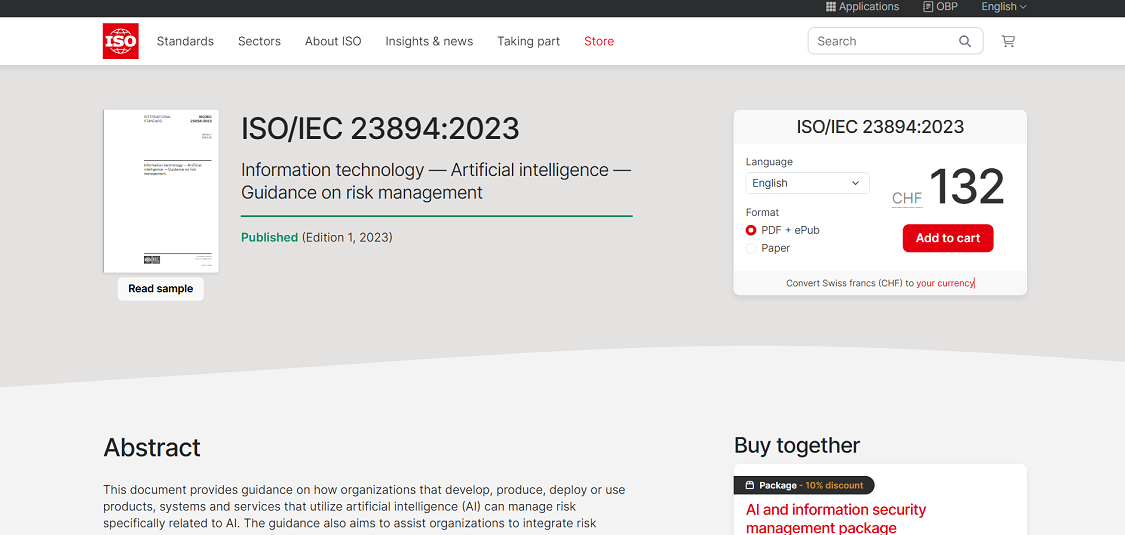Red teaming companies simulate real-world attacks to test cybersecurity defenses, compliance, and crisis response, offering unbiased assessments and tailored security recommendations.
Fergal Glynn

Organizations are increasingly relying on AI for predictive analytics, agentic solutions, and intelligent decision-making. However, the same autonomy that makes AI so powerful also introduces new risks. For example, models require access to a significant volume of sensitive data to function and can operate in unpredictable ways if left unchecked.
While traditional cybersecurity frameworks provide a strong foundation for AI security, they weren’t built to handle AI-specific threats. That’s why many organizations are turning to standards like ISO/IEC 23894.
ISO/IEC 23894 is an international standard for AI risk management that offers a clear and actionable framework for identifying, evaluating, and mitigating the many threats unique to AI systems.
In this article, we’ll dive into what’s covered in ISO/IEC 23894, how it relates to other standards, and what you need to know about certification. We’ll also share four best practices for implementing the standard across your organization, common challenges you might encounter, and how to overcome them.

ISO/IEC 23894 is a voluntary international standard for AI risk management. Organizations that develop, deploy, or use AI-powered solutions can follow this framework to identify and mitigate potential risks. It’s especially valuable if you rely on third-party AI tools and want to collaborate with vendors to improve accountability.
Even though ISO/IEC 23894 isn’t legally required in most areas, following this standard can help you future-proof compliance while improving security. It helps organizations:
ISO/IEC 23894 is one of several international standards and frameworks that organizations can use to govern and manage AI risks. It’s often mentioned alongside ISO/IEC 42001 and NIST’s AI Risk Management Framework (AI RMF), but each serves a distinct purpose. The table below breaks down these AI standards and frameworks, their main focus areas, and key outcomes.
ISO/IEC 42001 and the NIST AI RMF primarily focus on building a governance framework. They help companies establish an AI management system (AIMS) for accountability. ISO/IEC 23894 goes further, offering practical guidance on the risk management process, including the identification, assessment, and mitigation of AI-specific risks throughout the AI lifecycle.
The NIST AI RMF, on the other hand, provides a more flexible, U.S.-centric approach that’s designed to help organizations implement trustworthy AI practices. This includes managing risks to achieve key trustworthy AI principles, such as fairness, explainability, and robustness.
Together, these standards and frameworks provide comprehensive guidance on AI risk management best practices. Using ISO/IEC 23894 alongside ISO/IEC 42001 or the NIST AI RMF gives your organization both the structure and the tactical guidance to manage AI responsibly, from governance to risk mitigation.
Unlike more traditional frameworks, ISO/IEC 32894 helps your team address risk at every stage of the AI lifecycle. It integrates risk considerations into every stage, making it a more continuous process rather than a one-and-done checklist. Follow these best practices to integrate ISO/IEC 23894 principles into your workflow.
Start by establishing your baseline. Conduct a comprehensive assessment to understand your current ecosystem and identify potential risks. This includes mapping:
The goal is to identify weak spots in your data and governance practices before layering on new controls.

Once you understand your risks, develop a tailored AI risk strategy that aligns with your organization’s structure and objectives. It should include:
The key is to integrate the risk strategy with your workflow. You may need to revisit processes, update documentation, or involve cross-functional teams, but the end result is sustainable, organization-wide accountability for AI risk.
ISO/IEC 23894 takes a “privacy by design” approach to risk management. The framework requires building risk mitigation measures directly into your AI systems by default. Depending on your risk profile and regulatory environment, you may need to customize your mitigation approach. Key actions include:
Embed these steps into your existing SDLC or MLOps workflow to make compliance seamless and reduce developer friction.
Well-designed AI models can still exhibit unexpected behavior in production environments. That’s why ISO/IEC 23894 emphasizes continuous testing to identify potential vulnerabilities early.
This includes simulating realistic edge cases, malicious inputs, and adversarial scenarios. Red teaming is also crucial for finding hidden vulnerabilities that traditional QA might overlook. Mindgard’s Offensive Security solution automates the red teaming process by proactively probing for model weaknesses, allowing you to harden AI systems before problems arise.
Unlike ISO/IEC 42001, ISO/IEC 23894 isn’t a certifiable standard, so there’s no formal audit or certification process. This standard was developed to help organizations manage AI risk responsibly. That said, you can still demonstrate adherence to its principles through documented evidence and alignment with related frameworks.
Here are a few ways to demonstrate your compliance with ISO/IEC 42001:
By taking these steps and maintaining evidence of compliance, you can demonstrate that your organization is serious about the responsible use of AI.
Implementing ISO/IEC 23894 can be challenging, particularly for organizations that are still developing their AI capabilities. Here are some of the most frequently encountered issues, along with practical advice for overcoming them.
A common barrier to executive buy-in is a lack of AI literacy, which limits leaders’ understanding of the models in use, associated risks, and regulatory requirements. When leaders are unfamiliar with these concepts, they may perceive AI risk management as an area with limited impact and resource value.
To address this, provide cross-functional AI training that helps leadership, compliance, and technical teams communicate and understand one another. Tailored workshops and internal briefing sessions can bring awareness to how AI risks can impact business outcomes, regulatory readiness, and enterprise-wide risk profiles.
AI teams focused on fast-paced development cycles and deployments often perceive risk management activities as speed bumps rather than enablers of faster, safer AI. Risk reviews and oversight may be applied erratically across different teams and projects, weakening overall governance standards.
To overcome this challenge, automate as many checks and documentation requirements as possible. Embedding validation, bias detection, and interpretability assessment tools in your existing CI/CD or MLOps pipelines ensures AI risk management moves at the same pace as development.
Tools like Mindgard’s Offensive Security solution make this integration practical. Mindgard automates AI artifact scanning, red teaming, and continuous validation throughout the development process, allowing teams to discover vulnerabilities, track model lineage, and enforce governance controls without slowing delivery.
Mindgard’s AI Artifact Scanning capabilities provide comprehensive, real-time detection of configuration errors, bias issues, and exposure risks, giving developers and compliance teams unified visibility. This level of automation transforms AI risk management from a reactive process into a built-in safeguard that supports agile, secure innovation.
Organizations with existing information security (ISO/IEC 27001) or privacy-related governance frameworks (GDPR, CCPA) may struggle to adopt additional, AI-specific requirements without duplication and overlap.
To address this challenge, align ISO/IEC 23894 controls with related governance frameworks, such as the ISO/IEC 42001 standard or the NIST AI RMF, to the greatest extent possible. Mapping ISO/IEC 23894 to related standards and frameworks can prevent duplication, streamline auditing, and help unify risk management activities under a consistent set of governance practices.
Implementing ISO/IEC 23894 integrates risk management directly into your AI development workflows. Rather than treating risk mitigation as a one-time exercise, this standard ensures your team evaluates and addresses risk continuously, across design, training, deployment, and maintenance. While ISO/IEC 23894 isn’t legally required, it provides a practical blueprint for mitigating AI risks before they lead to real-world consequences.
However, the level of testing and validation required by the ISO/IEC 23894 standard can place a heavy burden on development resources. Mindgard’s Offensive Security solution helps bridge the gap by automating AI stress-testing and red teaming to identify vulnerabilities before they’re exploited. Book a Mindgard demo to find out how robust your AI really is.
ISO/IEC 23894 is a voluntary standard focused specifically on AI risk management. While other standards, such as ISO/IEC 42001 or the NIST AI RMF, address broader governance and accountability frameworks, ISO/IEC 23894 zeroes in on identifying, assessing, and mitigating AI-specific risks. It serves as a practical playbook that complements these wider governance standards.
It’s unlikely. Compliance with ISO/IEC 23894 is voluntary in most jurisdictions. However, following it can strengthen your organization’s resilience against emerging AI risks and help prepare for future regulations. Adopting the standard early demonstrates proactive governance and positions your business as a responsible AI leader.
Because ISO/IEC 23894 is voluntary, there is no regulatory body enforcing compliance. Organizations choose to implement it to enhance internal governance and align with global best practices. The ISO and IEC frameworks provide guidance, not enforcement, helping organizations build a strong foundation for future regulatory readiness.